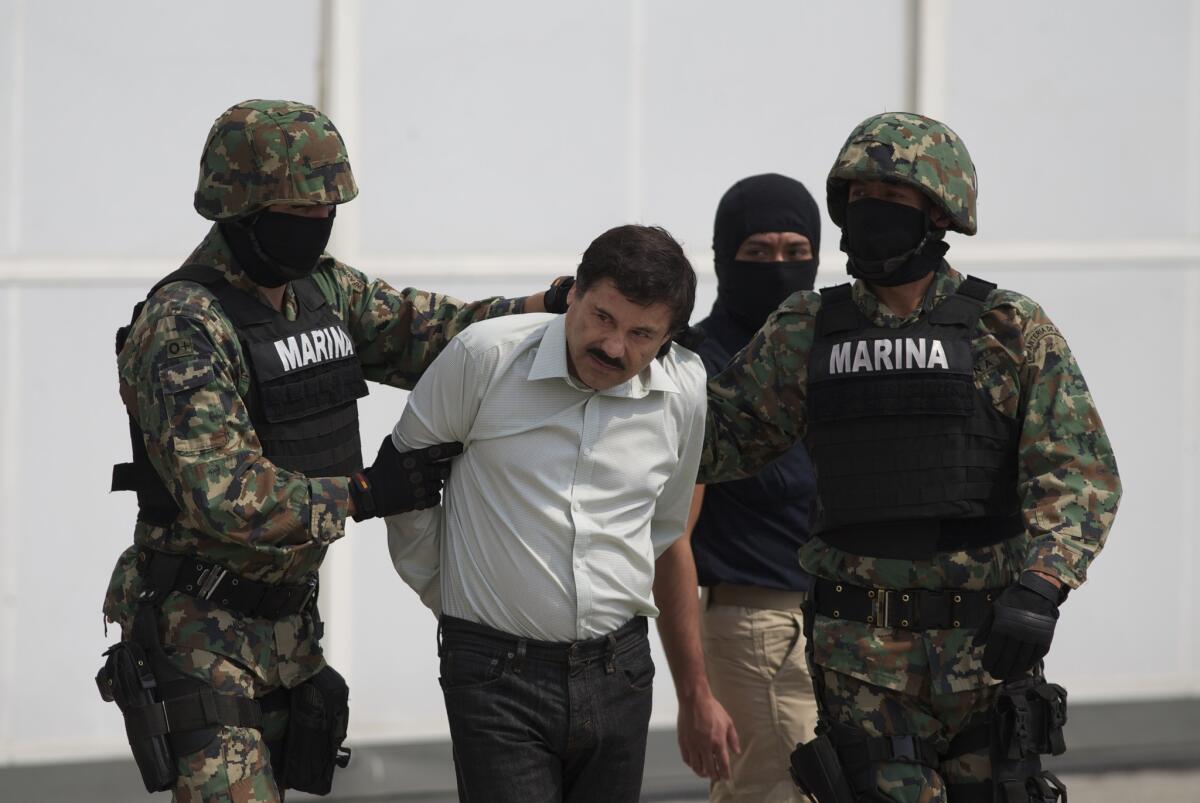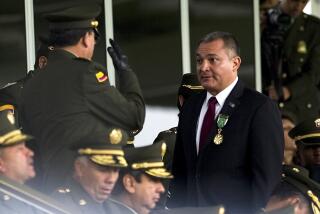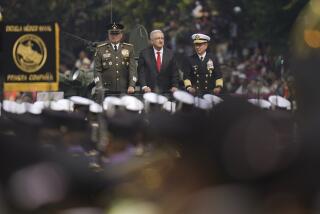Got Shorty: Guzman caught in joint U.S.-Mexico raid, official says

MEXICO CITY -- Mexico’s most wanted drug lord, Joaquin Guzman, known as “El Chapo,” was captured Saturday in a joint operation by Mexican and U.S. federal agents, a senior U.S. official said.
Guzman, long considered the top prize and most elusive figure in the ongoing drug war that has left tens of thousands of Mexicans dead, was taken into custody before dawn at a hotel in the seaside Sinaloa resort town of Mazatlan.
Guzman led the Sinaloa cartel, the most powerful, richest and oldest of the drug-trafficking networks in Mexico. The group is responsible for the shipment of tons of cocaine and marijuana to the U.S.
FULL COVERAGE: Mexico Under Siege
The senior official said Guzman was being transported to Mexico City, and reports from Sinaloa said the Mazatlan airport had been completely shut down. The source said no shots were fired in the capture, which was based on information from an informant. Mexican sources said DNA tests were being conducted to verify Guzman’s identity. A photograph of a bare-chested man arrested in the operation was being circulated in Mexico; it did not look very much like Guzman, but he has not been officially seen in public for many years.
In recent days, the Mexican marines have been raiding numerous properties in Sinaloa belonging to close associates of Guzman and had captured several high-level lieutenants. It is possible one of them fingered Guzman’s whereabouts.
Guzman was arrested in Guatemala in 1993 but escaped dramatically from prison in 2001 -- supposedly by hiding in a laundry cart -- and has been on the lam ever since, despite numerous reported sightings.
His latest wife, a former beauty queen, gave birth to twins three years ago in the Los Angeles area. U.S. Drug Enforcement Administration officials tracked her, in hopes of finding Guzman, but were unsuccessful.
The U.S. offered a $5-million bounty for his capture. In Washington, Department of Justice officials declined to comment before the Mexican government made an official announcement. But one federal law enforcement official said interest was high in working with the Mexican government to get Guzman extradited to the U.S. to face charges.
“He’s already escaped from one Mexican jail,” the official said. “Now we want him.”
Guzman, who is 56 or 57, has close-set eyes and stands about 5 feet 6, earning him his widely known nickname “El Chapo,” Spanish for “Shorty.”
It is unclear what his removal from Mexico’s vast drug-trafficking business will mean. Several experts said he was already sufficiently distanced from day-to-day operations that his absence will not be noticed. In the past, the elimination of a top drug lord has led to a bloody power struggle among the next tier of lieutenants. In the case of the Sinaloa cartel, Guzman’s long-time partner, Ismael “El Mayo” Zambada, already controlled much of the operation.
“It will mean absolutely nothing. It does not mean the end of the Sinaloa cartel,” Ricardo Ravelo, a prominent writer on Mexican drug-trafficking, said in a radio interview.
But it will be, he added, an important victory for the government of President Enrique Pena Nieto, who has been accused of ignoring the drug cartel problem and, in fact, favoring the Sinaloa cartel over its even more bloody rivals like the Zetas
Guzman has been most notably charged in two federal grand jury indictments in the U.S. – in Chicago in 2008, and In El Paso in 2012.
In the Chicago case, the more sweeping of the two, he is charged along with 10 other Sinaloan cartel leaders in a massive indictment for moving heroin and cocaine into this country after his organization merged with another “affiliated cartel” and formed an alliance knows as “the Federation.”
But that agreement later fractured, and since then, according to the “special grand jury“ impaneled just to look at the cartel case, Guzman and other leaders “became engaged in a violent war in Mexico over various issues, including control of lucrative narcotics trafficking routes into the United States.”
Guzman’s network concentrated on “trafficking activities to import multi-ton quantities of cocaine from Central and South American countries, including Colombia and Panama, to the interior of Mexico,” the indictment said.
Guzman’s group then oversaw “shipments of hundreds of kilograms at a time” of cocaine, “as well as multi-kilogram quantities of heroin, from Mexico across the United States and then into and throughout the United States.”
The grand jury identified Guzman as “the leader” and “head” of the operation, and said he often personally obtained and negotiated the price for cocaine and heroin flowing up into the U.S.
To first get the drugs into Mexico, for movement into the U.S., the Guzman cartel used “Boeing 747 cargo aircraft, private aircraft, submarines and other submersible and semi-submersible vessels, container ships, go-fast boats, fishing vessels, buses, rail cars, tractor-trailers and automobiles,” the indictment said.
The drugs were then “smuggled” to the U.S. border, the indictment said, and once over the border, the drugs were ferried by truck drivers to major cities across the U.S., including Los Angeles, Chicago, New York, Detroit, Philadelphia, Cincinnati and Washington. Another route went to Vancouver, Canada.
As the drugs flowed north, the money moved south, the indictment said, with “millions of dollars in cash” stored in safe houses as it was gradually transferred to the cartel in Mexico. Guzman himself, the indictment said, “regularly received multimillion-dollar payments.”
To keep the drugs and money flowing, cartel operatives used “cellular telephones, satellite telephones, computers and hand-held PDAs,” the later otherwise known as Palm Pilots.
The Sinaloan cartel also was active in “obtaining guns and other weapons, bribing corrupt public officials, engaging in violence and threats of violence,” and other forms of intimidation.
They sought to acquire weapons from the U.S., and “discussed the use of violence against American and/or Mexican government buildings,” the indictment said.
The second federal indictment was filed under seal in April 2011 in El Paso, and U.S. authorities in West Texas did not announce it until February 2012. This time Guzman was named with 23 other cartel figures on charges focusing on cartel operations between El Paso and Ciudad Juarez in Mexico.
These charges came after two U.S. residents were killed on cartel orders in Ciudad Juarez. In one instance, after a cocaine and marijuana shipment went missing in the U.S., a cartel “kidnap team “ in 2009 grabbed an individual in Horizon City, Texas, tortured him in Ciudad Juarez and killed him. His mutilated body was later found there.
In a second episode in 2010, a bridegroom was kidnapped at his wedding in Ciudad Juarez, along with his brother and uncle. According to the indictment, all three were tortured and slain, their bodies discovered in the bed of a pickup.
“There are several assassins and hit-squad members,” said Joseph Arabit, special agent in charge for the Drug Enforcement Administration in El Paso, in announcing the indictment.
Guzman also has been charged in other indictments in San Diego and Arizona. In all, his maximum punishment if convicted range from the death penalty to life in prison with no parole.
wilkinson@latimes.com
richard.serrano@latimes.com
Staff writers Wilkinson reported from Mexico City and Serrano from Washington
More to Read
Sign up for Essential California
The most important California stories and recommendations in your inbox every morning.
You may occasionally receive promotional content from the Los Angeles Times.












